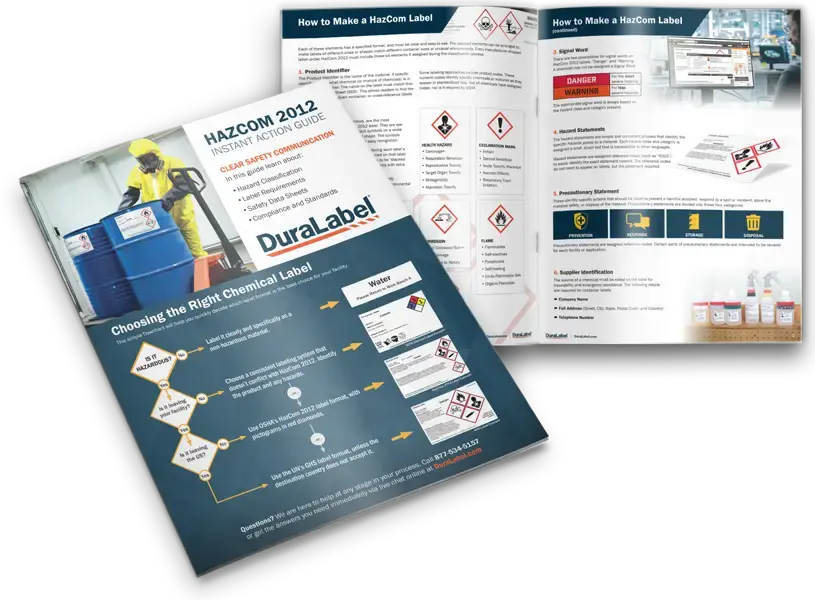Lab Safety Labels

Permanent Container Safety Labels
OSHA requires employers to ensure that no worker uses, stores, or allows any other person to use or store any hazardous substance in a laboratory, if the container does not meet OSHA safety labeling requirements. Safety labels are required on all types of containers, including bags, barrels, bottles, boxes, cans, cylinders, drums and reaction vessels. These requirements are given in OSHA's Hazard Communication Standard [29 CFR 1910.1200(f)(1)], and include:
- The chemical type and the correct hazard warnings must be on the safety label.
- The safety label must display a warning that provides the primary health and physical hazards of the material by using a combination of words, pictures, and symbols.
- The name and address of the responsible party (e.g. manufacturers and importers) must be included on the safety label.
- The safety label must be in English, easily read, and permanently displayed.
Secondary Container Safety Labels
Laboratory use of chemicals typically requires chemicals to be transferred into secondary containers such as bottles, flasks, cans, or beakers. Labels on portable containers are not required if the person who made the transfer uses all of the contents during the work shift and stays in control of the container at all times. However, secondary containers must comply with the safety labeling requirements listed above if any of the following conditions exist:
- The material is not used within the work shift of the person who made the transfer.
- The person who made the transfer leaves the work area.
- The container is moved to another work area and is no longer in the possession of the person who filled the container.
- Labels on portable containers are not required if the person who made the transfer uses all of the contents during the work shift.
A safety label needs to be applied to the secondary container any time it is not used in a single shift or is outside the control of the person who made the transfer. This label must provide the identity of the hazardous chemical(s) in the container and the hazards the chemical(s) present.
Replacement Container Safety Labels
The label on a container entering the workplace must not be removed, altered, or defaced. If the original safety label must be replaced, the replacement must contain the same information as the original. The new label must not be obscured or damaged by the liquid in the container.
Duralabel offers a comprehensive line of labeling supplies that resist moisture, temperature extremes, petroleum products, chemicals, and many solvents.
Lab Safety Label Regulations
OSHA's Occupational Exposure to Hazardous Chemicals in Laboratories (1910.1450) is a series of regulations governing safe practices in laboratories. More commonly referred to as the Laboratory Standard, 1910.1450 limits exposure to hazardous laboratory chemicals in laboratories.
Laboratories are required to develop a Chemical Hygiene Plan (CHP) that addresses every aspect of the Laboratory Standard, to protect laboratory workers from harm due to hazardous chemicals. This includes maintaining proper safety labels within these facilities.
Safety Labels and Receiving: 1910.1450 requires that safety labels on incoming shipments are properly maintained. Laboratories are responsible for making sure that the original labels are not altered, removed, or defaced in any manner.
Safety Labels and Storage: The Laboratory Standard requires that all hazardous chemicals are clearly labeled with the proper signal word and hazard type. Permanent storage must adhere to HazCom 2012, as described in 1910.1200.
Safety Labels and Shipping: When a laboratory produces a chemical for another facility or outside use, the laboratory is required to create and maintain labels and safety data sheets as a "chemical producer," under the rules of HazCom 2012.
In general, the Laboratory Standard relies on other regulatory standards for specific chemical, biological, and radiological hazards, which include the following:
- Hazard Communication Standard (HazCom 2012, 1910.1200)
- Bloodborne Pathogens standard (1910.1030)
- Formaldehyde standard (1910.1048)
- Ionizing Radiation standard (1910.1096)
- Air Contaminants standard (1910.1000)
How Can Duralabel Help with Lab Safety?
Labeling and signage are key components of successful lab safety. Labels and signs give workers the information required to understand workplace hazards.
DuraLabel industrial label and sign printers by Duralabel can help develop clear, custom visual communication. With a variety of printers and more than 50 specialty supplies, you'll find the right tools to ensure your labels meet OSHA regulations.
These signs and labels can promote employee safety, provide direction around the lab, and alert workers to vital information.
Not sure if your lab is OSHA compliant? Duralabel provides a Compliance Services that identifies potential hazards and ensures your facility is compliant with OSHA regulations.
Related Resources

Canadian TDG Labeling
The Canadian Transportation of Dangerous Goods (TDG) Act requires that containers holding dangerous materials ...
Read
CO2 Cylinder Tanks and the Art of Labeling
Dealing with dangerous substances is a major concern for any workplace. Whether it's chemicals that can burn ...
Read
DOT Labels
49 CFR 172.400 specifies that Department of Transportation (DOT) Labels must be used for hazardous materials ...
Read.png)





